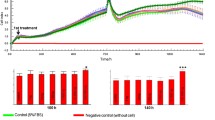Abstract.
To determine the role of amelogenin in the mineralization of dental enamel, the effects of the recombinant mouse amelogenin rM179 on in vitro hydroxyapatite formation have been studied. In a steady-state agarose gel assay for hydroxyapatite nucleation, rM179 lacked significant activity at concentrations up to 300 μg/ml. In an autotitration assay for inhibition of de novo hydroxyapatite formation, rM179 had no significant activity at concentrations up to 30 μg/ml. Using selected-area dark-field electron microscopy, it was shown that rM179, at concentrations up to 30 μg/ml, did not significantly affect the length of hydroxyapatite crystals formed in steady-state agarose gels. These findings suggest that amelogenins do not possess the specific crystal-modulating properties characteristic of certain acidic mineralized tissue proteins proteins.
Similar content being viewed by others
Author information
Authors and Affiliations
Additional information
Received: 2 September 1998 / Accepted: 17 February 1999
Rights and permissions
About this article
Cite this article
Hunter, G., Curtis, H., Grynpas, M. et al. Effects of Recombinant Amelogenin on Hydroxyapatite Formation In Vitro . Calcif Tissue Int 65, 226–231 (1999). https://doi.org/10.1007/s002239900688
Issue Date:
DOI: https://doi.org/10.1007/s002239900688




